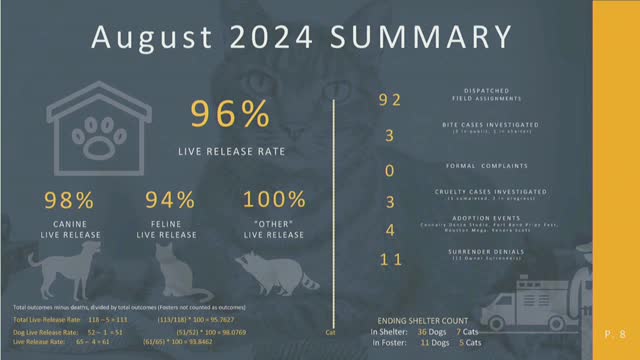Shelter defends no kill policy amid euthanasia debate
September 24, 2024 | Rosenberg, Fort Bend County, Texas
This article was created by AI summarizing key points discussed. AI makes mistakes, so for full details and context, please refer to the video of the full meeting. Please report any errors so we can fix them. Report an error »

During a recent government meeting, discussions centered on the operational standards and practices of local animal shelters, particularly regarding their \"no kill\" status. The term \"no kill\" is defined nationally as saving at least 90% of animals that leave a shelter alive. However, local officials reported a higher success rate of 96%, raising questions about the criteria used to classify animals as sick or injured.
One official clarified that while the shelter aims to minimize euthanasia, it is still necessary in cases of severe medical conditions. The conversation highlighted the complexities of defining what constitutes a \"sick\" animal, with some officials noting that even minor issues, such as flea infestations, could categorize an animal as unhealthy.
When pressed about the number of animals euthanized in August, officials stated that none were put down if they were not sick or injured. This led to a debate about the semantics of the \"no kill\" label, with some arguing that any euthanasia, regardless of the reason, contradicts the concept of being a no-kill shelter.
The meeting also touched on the shelter's protocols for handling animals brought in by the public. Officials mentioned that they do not allow animals to be dropped off without prior approval to prevent disease transmission. They also noted that while there have been instances of animals being abandoned outside the shelter, they have not observed any animals being improperly left at the facility.
Overall, the discussions underscored the challenges faced by animal shelters in balancing care for animals with the realities of medical needs and community expectations regarding euthanasia practices.
One official clarified that while the shelter aims to minimize euthanasia, it is still necessary in cases of severe medical conditions. The conversation highlighted the complexities of defining what constitutes a \"sick\" animal, with some officials noting that even minor issues, such as flea infestations, could categorize an animal as unhealthy.
When pressed about the number of animals euthanized in August, officials stated that none were put down if they were not sick or injured. This led to a debate about the semantics of the \"no kill\" label, with some arguing that any euthanasia, regardless of the reason, contradicts the concept of being a no-kill shelter.
The meeting also touched on the shelter's protocols for handling animals brought in by the public. Officials mentioned that they do not allow animals to be dropped off without prior approval to prevent disease transmission. They also noted that while there have been instances of animals being abandoned outside the shelter, they have not observed any animals being improperly left at the facility.
Overall, the discussions underscored the challenges faced by animal shelters in balancing care for animals with the realities of medical needs and community expectations regarding euthanasia practices.
View full meeting
This article is based on a recent meeting—watch the full video and explore the complete transcript for deeper insights into the discussion.
View full meeting
